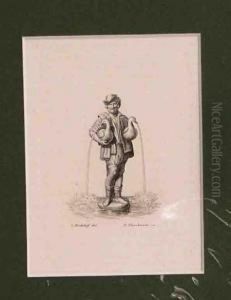Peter, Le Jeune Ii Vischer Paintings
Peter Vischer the Younger, born in 1487 in Nuremberg, Germany, was a notable sculptor of the Renaissance period. He stemmed from a renowned family of artists, most prominently being the son of Peter Vischer the Elder, a celebrated German sculptor and the mastermind behind the famous Shrine of St. Sebaldus. Growing up in the artistic environment of his father's workshop, Peter II was steeped in the traditions of metalworking and sculpture from a young age, which profoundly influenced his career path and artistic development.
Peter II worked closely with his father and his brothers on numerous projects, contributing to the legacy of the Vischer family in the world of late Gothic and early Renaissance art. After his father's death in 1529 (a year after Peter II's own death, suggesting a mix-up in dates or confusion in records, as historical accounts often vary), the responsibility of the family workshop fell to his brother Hans initially, indicating the collaborative nature of the family's artistic enterprise.
Despite living in the shadow of his father's monumental reputation, Peter the Younger managed to carve out his own niche in the realm of sculpture. He is known to have continued the family tradition of crafting bronze sculptures, bringing his own unique style and refinement to the pieces he created. The period was marked by a transition from Gothic to Renaissance art, and Peter II's works reflect this shift, showcasing a blend of meticulous Gothic detail and the emerging Renaissance emphasis on humanism and naturalism.
However, compared to his father and his brother Hans, less is known about the specifics of Peter II's contributions. This scarcity of information is partly due to the collaborative nature of the Vischer workshop, where individual contributions were often absorbed into the collective output of the family enterprise. Nonetheless, Peter II's involvement in projects such as the expansion and embellishment of the St. Sebaldus Shrine, among other works, underscores his role in the continuation and development of the Vischer artistic legacy.
Peter Vischer the Younger died in 1528 in Nuremberg, his contributions to the family's oeuvre and the broader sphere of German Renaissance art marking him as a significant, though somewhat overlooked, figure in the history of sculpture. His legacy, like that of the Vischer family, is encapsulated in the enduring metalworks that continue to be admired for their craftsmanship and artistic merit.
